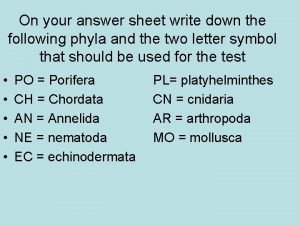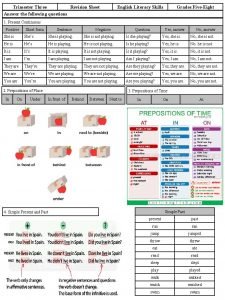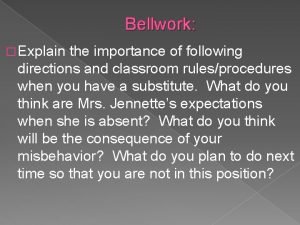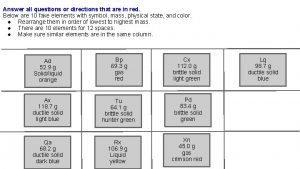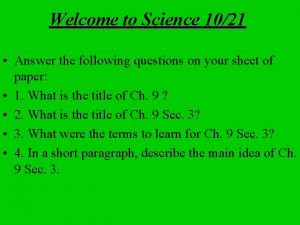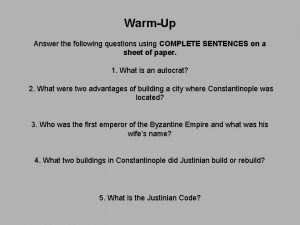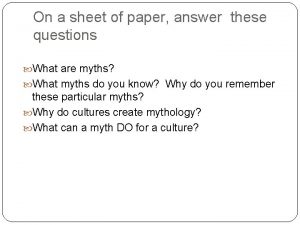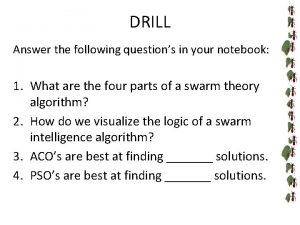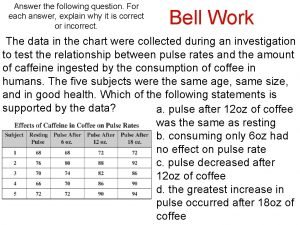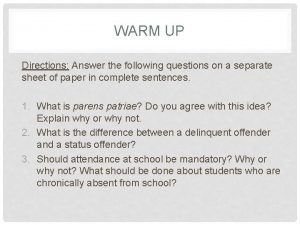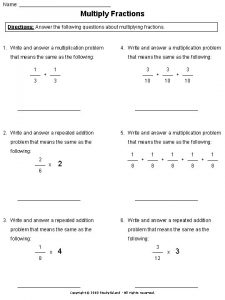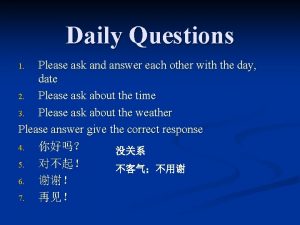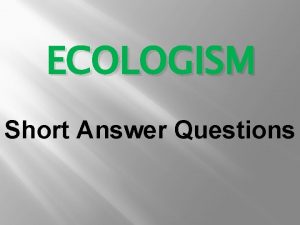DIRECTIONS Please answer each of the following questions
















- Slides: 16

DIRECTIONS • Please answer each of the following questions in COMPLETE SENTENCES. Record your answers on sheets of lined paper; and please number each question and leave space between each response as well. • Please work INDEPENDENTLY while working through these questions, which means that you should not be communicating with your classmates. • You must bring your paper to me when finished for feedback and a visual inspection. • Lastly, you will self-assess the quality of your responses using an answer key provided by the teacher. You will be required to complete a self-assessment form as part of your reflection of performance.

1 The chart below shows the properties of the most common forms of matter found on Earth. Properties No definite shape Definite volume Definite shape Definite volume No definite shape No definite volume State of Matter A B C • What is the identity of states A, B, and C?

2

3 What conclusion can be reached after analyzing the results of the experiment?

4 • What will most likely happen to the water in the glass tube if heating continues?

5 • What state of matter is being shown in each particle diagram below?

6 • According to the data table, what is the relationship between pressure and the volume of a gas sample? Read the chart from top to bottom to help you form a response.

7 • The diagram represents four processes, labeled A, B, C, and D, that occur when water changes phase. What are the names of process A, B, C, and D?

8 • The diagram represents four processes, labeled A, B, C, and D, that occur when water changes phase. What do processes A and B have in common?

9 • The diagram represents four processes, labeled A, B, C, and D, that occur when water changes phase. What do processes C and D have in common?

10 • The diagram represents four processes, labeled A, B, C, and D, that occur when water changes phase. What 2 processes increase particle motion?

11 • The diagram represents four processes, labeled A, B, C, and D, that occur when water changes phase. What 2 processes decrease particle motion?

12 • The diagram below shows a model of the water cycle. • Why would the level of the muddy water inside the bowl DECREASE if the model is left in a sunny location for several days?

13 • The diagram below shows a model of the water cycle. • How did the drops of water on the underside of the plastic wrap form?

14

15
 Please answer the following questions
Please answer the following questions On your answer sheet, answer the following questions
On your answer sheet, answer the following questions Trimester fill in worksheet answers
Trimester fill in worksheet answers Will you please be quiet please summary
Will you please be quiet please summary Look at the picture then answer the following question
Look at the picture then answer the following question Look at the pictures. answer the questions
Look at the pictures. answer the questions Look at the pictures answer the following question
Look at the pictures answer the following question Classroom rules and procedures
Classroom rules and procedures Solid answer
Solid answer Test directions for multiple choice
Test directions for multiple choice Answer the following questions science
Answer the following questions science Dress code in a sentence
Dress code in a sentence Use the graph at the right to answer the question below
Use the graph at the right to answer the question below On a sheet of paper, answer the following questions.
On a sheet of paper, answer the following questions. In pairs answer these questions
In pairs answer these questions C) answer the following questions on your notebook
C) answer the following questions on your notebook Answer the question in your notebook
Answer the question in your notebook

